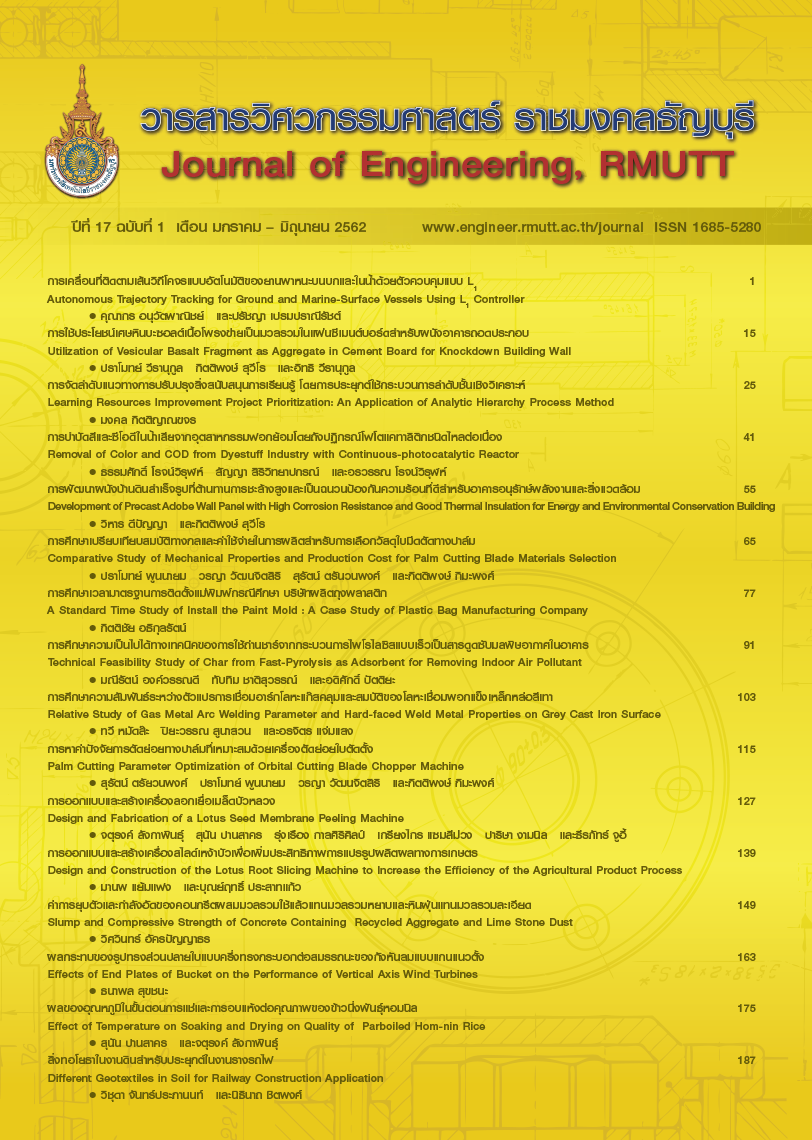Autonomous Trajectory Tracking for Ground and Marine-Surface Vessels Using L1 Controller
Main Article Content
Abstract
This research paper presents studies of applying autonomous trajectory-tracking logic for 4-wheel car robot and catamaran robot using an L1 controller. A trajectory computation toward specified target points need to calculate a centripetal-acceleration command, described by distance (L1) and damping ratio (x) parameters, such that vehicle can approach the desired straight-path trajectory. Effect of three parameters: 1) L1, 2) x and 3) proportional gain (Kps) of a PID control for steering, on efficiency of autonomous trajectory tracking of both vehicles are evaluated from 1) an average error of a perpendicular distance from vehicle toward the specified path or average cross-track error and 2) an average maximum error of overshoot from specified path. Experiments of autonomous trajectory tracking reveal that 4-wheel robot car, governed by the L1 controller, approaches desired trajectory similar to an overdamped response. Robot car trajectory is not sensitive to L1 and x parameter variations because a 4-wheel car dynamic has good traction capability during a sharp turn. On the contrary, catamaran can slideways in water because of small hydrodynamics drag force. As a result, L1, x, Kps, variations have strong effects on a performance of the autonomous trajectory tracking. Using small L1 and Kps, catamaran can track specified straight trajectories automatically with good performance
Article Details
The manuscript, information, content, picture and so forth which were published on Frontiers in engineering innovation research has been a copyright of this journal only. There is not allow anyone or any organize to duplicate all content or some document for unethical publication.
References
Mu D, Zhao Y, Wang G, Fan Y and Bai Y. Course control of usv based on fuzzy adaptive guide control. 2016 Chinese Control and Decision Conference (CCDC). 2016 : 6433-6437.
Changshun W, Huang Z, Yu Y. USV trajectory tracking control system based on ADRC. 2017 Chinese Automation Congress (CAC). 2017 : 7534-7538.
Park S, John D, Jonathan H. A New nonlinear guidance logic for trajectory tracking. AIAA Guidance, Navigation, and Control Conference and Exhibit, Guidance, Navigation, and Control and Co-located Conferences. 2004.
Idris M H B M, Kamarudin M A A B C, Sahalan M I, Abidin Z B Z, Rashid M M. Design and development of an autonomous surface vessel for inland water depth monitoring. 2016 International Conference on Computer and Communication Engineering (ICCCE). Kuala Lumpur. 2016 : 177-182.
ArduPilot Dev Team. ArduPilot mega [Internet]. 2017 [cited 2017 May 15]. Available from: http://www.ardupil ot.co.uk (in Thai)
Sinisterra A, Dhanak M, Kouvaras N. A USV platform for surface autonomy.OCEANS 2017 – Anchorage. 2017 : 1-8.
Hassan S, Alam M, Siddiqui N A, A A Siddiqui, M T Qadri. Designing and control of autonomous Unmanned Ground Vehicle. 2017 International Conference on Innovations in Electrical Engineering and Computational Technologies (ICIEECT). 2017 : 1-5.
Boonyarak S, Prempraneerach P. Real-time obstacle avoidance for car robot using potential field and local incremental planning. 201411th International Conference on Electrical Engineering/Electronics, Computer, Telecommunications and Information Technology (ECTI-CON). 2014 : 1-5.
Prempraneerach P. Trajectory tracking using sliding mode control for autonomous surface vessel. 2016 International Computer Science and Engineering Conference (ICSEC). 2016, pp. 1-6.
Yiengveerachon V. Engineering surveying.2. Bankok : Chulalongkorn University Press. Bankok. 2016 (in Thai).


